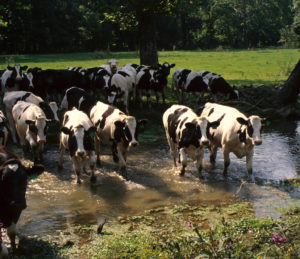
Cows crossing a stream (via Chesapeake Bay Program)
Cows wading in a stream might make a pretty picture. But the reality is a lot less pleasant.
Jinjun Kan is a microbiologist with Stroud Research Center. He’s been monitoring streams in the Delaware River Watershed for bacteria that are present as a result of fecal contamination. And he’s found high levels, especially in summer.
Kan: “We try to understand why we have the high number of bacteria… And how can we reduce those bacteria.”
Kan says possible causes include leaky septic systems and runoff from nearby farm fields. But wading cows also contribute by excreting waste directly in the water.
So he says fencing livestock out of streams is one step farmers can take to help protect water quality.
Get Schooled:
- Learn more about efforts to keep livestock out of streams in the Chesapeake Bay watershed, from the Baltimore Sun.
- Read more about more sustainable practices for grazing streamside pastures, from the University of Wisconsin Extension.
- Read up on livestock grazing management impacts on stream water quality, from the Journal of the American Water Resources Association.
The fine print:
- This segment was produced in partnership with Cornell University’s Atkinson Center for a Sustainable Future




